

Shaping the Sustainable Organization: Diagnostic. Economic growth for the good of all: Sustainable and inclusive. As the world economy starts to emerge from the COVID-19 crisis, the time will soon come for leaders to look beyond safeguarding lives and livelihoods and to set their sights on a more profound challenge: bettering them.

This societal challenge might be ten times as big as the pandemic and last ten times as long. The three goals we have in mind—growth, sustainability, and inclusion—buttress one another yet don’t always pull in the same direction; we see powerful reinforcing as well as counteracting loops among them (exhibit). And so, while many might broadly agree on the aspiration, there’s a very tough question lurking in the background: How do we go about building a future that delivers growth and sustainability and inclusion? We strive to provide individuals with disabilities equal access to our website. UN Global Compact—Accenture CEO Study on Sustainability. Shaping the Sustainable Organization. Putting Sustainability DNA in action AB InBev - Innovating to close the loop Challenge: Reducing waste throughout the supply chain.
Solution: AB InBev has set a goal of “closing the loop” throughout its value chain – for 100% of primary packaging to be returnable or made from majority-recycled content – by 2025. Collaboration is central to these efforts. Since 2017, the AB InBev team has enhanced its strategic engagement with suppliers big and small, including forging new partnerships with local entrepreneurs through its 100+ Accelerator program. Business digs deep for sustainability. Changes in the business climate—and the climate—can cause leaders to rethink the ways in which value is created and lost.
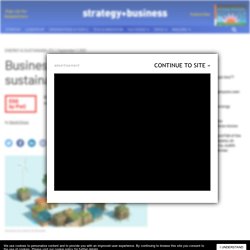
In July, Patti Poppe, CEO of California utility PG&E, said that the company is undertaking a US$20 billion capital-intensive effort to bury 10,000 miles of power lines. Why? Certified B Corporation. Six Steps to a Sustainability Transformation. On the basis of our extensive experience working with companies and investors to drive sustainability transformations, we have identified six actions that distinguish leaders from the rest of the pack: Develop a sustainability strategy anchored in purpose.Capture business value.Build new sustainable businesses.Make the core sustainable.Build capabilities.Own the narrative, and engage investors and stakeholders.

Companies that fail to take up the challenge, and instead continue to view sustainability through a compliance or ESG reporting lens, will miss the opportunity to tap into lucrative new markets and create new, winning business models. They will also see their space for creating shareholder value narrow dramatically. On the other hand, companies that execute effectively in all six areas will truly transform their business and turn sustainability into a competitive advantage. The Green Economy Has a Resource-Scarcity Problem.
Four Steps to Sustainable Business Model Innovation. The power of this diagram (versus more traditional, linear depictions) comes in part from its ability to reveal where delays, rebound effects, or tipping points might be active in the system.
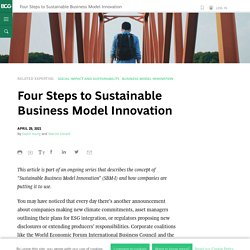
For instance, the node labeled “environmental and recycling awareness” will influence changes in several consumer habits—but only after a delay. Such awareness cannot be seen as a quick-fix solution, but over time it will help change the dynamics of the entire system. The boxes in the exhibit represent the opportunity spaces or strategic intervention points (SIPs) that become evident during this step. How executives can help sustain value creation for the long term. Ample evidence shows that when executives consistently make decisions and investments with long-term objectives in mind, their companies generate more shareholder value, create more jobs, and contribute more to economic growth than do peer companies that focus on the short term.

Data also show that companies can achieve better long-term performance when they address the interests of employees, customers, and other stakeholders. But a survey of approximately 500 global executives conducted by FCLTGlobal and McKinsey shows that many continue to feel pressure from shareholders and directors to meet near-term earnings targets at the expense of long-term strategies. Video Kevin Sneader and Sarah Williamson describe insights from their report on long-term value creation. OUR MISSION IS TO ACCELERATE THE TRANSITION TO A CIRCULAR ECONOMY. Dale Vince has a winning strategy for sustainability. In 2010, when Dale Vince purchased his local soccer club, his primary motivation was to save it from bankruptcy.
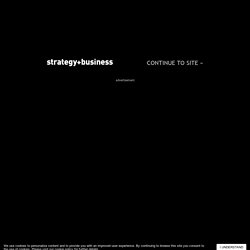
But Vince, the founder of the British company Ecotricity — which says it was the first company in the world to sell green electricity — soon realized he could transform the club into a model for sustainability. By serving only vegan food to players and fans, capturing rainwater to irrigate the organic field, and installing solar panels and electric vehicle charging points at the stadium, he has since turned Forest Green Rovers into what FIFA, global soccer’s organizing body, in 2018 called the greenest soccer club in the world.
And he has plans to go even greener. A closer look at Vince’s life and career quickly illuminates why he would undertake such an endeavor. He describes himself as an econaut: an environmentalist, businessperson, and inventor. Accelerating our path forward for sustainable business. The observance of Earth Day provides us all with an opportunity to reflect on the global environmental challenges that threaten our future well-being.

With less than 30 years left to reach the goal of net zero greenhouse gas emissions, the imperative to take action now to make lasting progress on sustainability is stronger than ever. The need to address climate change has been at the forefront of public policy debates for some time. But in the past year, as with so many issues, COVID-19 accelerated trends already underway – in this case, the severe economic impact of the pandemic revealed how interconnected the world has become and how dependent we are on the earth’s resources.
For companies around the world, responding to climate change is a necessity not just for the health of the planet, but according to a new IBM survey, for the health of their business as well. Long-Term Leadership: Pursuing Agility. Wharton@Work It’s easy to stay focused on the external forces disrupting your business, especially when they involve a catastrophe on a global scale.

But that narrow view can prevent you from correcting existing internal weaknesses that the pandemic exposed — weaknesses such as supply chains that were just one disruption away from failing. As Gad Allon, Wharton professor of operations, information and decisions, explains, companies spent years invested in efficiency above all else. “They outsourced as much as possible, moved operations off shore, and cut costs in other ways. How to Build Sustainable Business Advantage in a World Where Great Is No Longer Good Enough. Great performance in the 21st century is all about delivering consistently strong returns to shareholders—right?
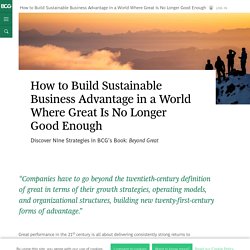
Wrong. That may have been true in the 20th century, when the rules of the business game were predictable, but not today. Hybrid Metrics: Connecting Shared Value to Shareholder Value. The Long Time Project. A Singular Focus on Profit Is No Longer an Option. Executive Summary When I began working at Sustainalytics in 2008, after completing an MBA in finance and sustainability, the business of rating companies on their environmental, social, and governance (ESG) performance was very much a niche field.
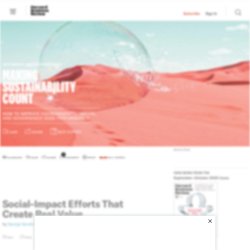
Our company had only 20 people in a single office in Toronto, where we produced reports on 300 companies, most of them Canadian firms traded on the Toronto Stock Exchange. Today we have 650 people based in North America, Europe, Asia, and Australia providing ESG research, ratings, and data on tens of thousands of companies. Eliminate-Reduce-Raise-Create Grid (ERRC Grid) Zero-based Supply Chain: Accelerating COVID-19 Recovery. Starbucks, PepsiCo, BMW to fix global supply chains. Operations-driven sustainability. The unexpectedly clean air that resulted in some places from steep COVID-19–induced drops in industrial activity appear unlikely to change a larger truth: the world is not yet on track to meet the greenhouse gas (GHG) emissions-reduction targets required by the 2015 Paris Climate Agreement. And it isn’t only the atmosphere that human activity is harming. At current growth rates, global annual waste generation would increase by 70 percent by 2050, while critical resources from minerals to clean water are being depleted at unsustainable rates.
Industrial activities are responsible for the lion’s share of global carbon emissions.